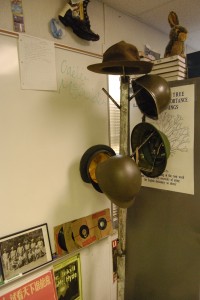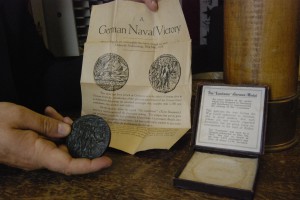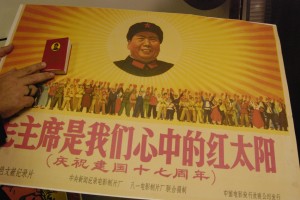Steve Hill’s mobile unit is a museum, and he is part curator, part tour guide, and all teacher. The décor isn’t pretty. There are no tassels, no window treatments, no striking color themes. It is, however, a constant lesson in history, and it covers almost every wall.
What do Hill’s students encounter each day?
 • Statuettes of ancient Greece and Rome, including Romulus and Remus
• Statuettes of ancient Greece and Rome, including Romulus and Remus
• Propaganda posters of Mao Tse-Tung
• WWI and WWII helmets
• Portrait photos of Martin Luther King, Jr., Elvis Presley and Teddy Roosevelt
• A student replica of “The Death of A. Maratâ€
• Personal plaques, awards and certificates
• Philadelphia sports memorabilia
• Images of the Vietnam War and WWII dog fighting planes
• Hanging maps
• A fallout shelter sign
• Shelves of history books
Of course, these fragments of history are useless without the historian. Hill is a storyteller, a historian to the core, and the lessons he teaches are filled with visual support, frequently straight from his trailer walls. His students learn about communist China with Maoist propaganda staring them in the face. They learn about the development of military firepower holding a 30 inch inert, wood and steel bullet in their hands.
Sometimes Hill wears the memorabilia, like a WWI doughboy ammunition belt and German hate belts adorned with buttons from slain soldiers.
Hill says on open house nights even parents, perhaps slightly concerned, ask about the image of an execution in the back of his room. He breaks into a history lecture, and soon they see what his students see all semester—the deep, complex, fascinating stories of history.
Can’t you just put pictures on Power Point?
Of course you can. Hill does, too. And, like many teachers, he enhances his instruction with film. But the memorabilia in his room has two advantages.
1. It’s  in the room the day students walk in the door, just waiting to be explained. It creates intrigue—a problem of sorts—whether students are inquisitive enough to ask about it or not. Students most frequently inquire about the WWI and WWII US, German, French, and West German helmets, which they finally come to understand when instruction reaches the 20th century.
2. It’s still in the room after Hill has incorporated an item into a lesson, rekindling that lesson each time the student sees it, strengthening the memory, the ability to recall. If Hill’s students stare off into space, chances are they’re accidentally reviewing history lectures.
 Hill explains, “Historic memorabilia adds another dimension to my teaching and student learning. I use the different artifacts to teach and inspire students to ask, “WHY?” Even if students are zoning-out, the visual treasure of history surrounding them in my classroom is teaching them by giving them visual anchors to history that can be cued in later instruction.â€
Hill explains, “Historic memorabilia adds another dimension to my teaching and student learning. I use the different artifacts to teach and inspire students to ask, “WHY?” Even if students are zoning-out, the visual treasure of history surrounding them in my classroom is teaching them by giving them visual anchors to history that can be cued in later instruction.â€
Mobile Unit 5 isn’t exactly the Smithsonian, but it is an extraordinary classroom and a wonderful place to learn.

